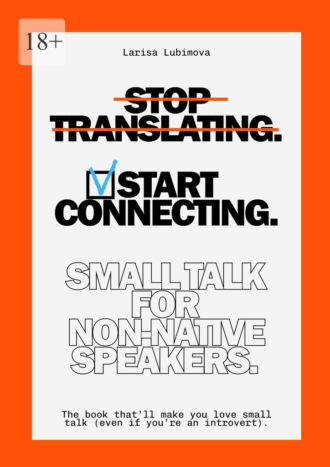
Полная версия
Stop Translating, Start Connecting: Small Talk for Non-Native Speakers. The book that’ll make you love small talk (even if you’re an introvert)

Stop Translating, Start Connecting: Small Talk for Non-Native Speakers
The book that’ll make you love small talk (even if you’re an introvert)
Larisa Lubimova
Дизайнер обложки Roman Lubimov
© Larisa Lubimova, 2025
ISBN 978-5-0068-0180-6
Created with Ridero smart publishing system
Introduction
Imagine this: After a 3-minute chat at a conference, someone emails you: ‘Let’s work together.’
This book is your cheat code.
Forget ‘How are you?’ – here’s what really works:
– How to hijack small talk to pitch ideas (without being pushy).
– Why Brits say ‘That’s interesting’ when they mean ‘This is bullshit’ (and how to decode it).
Warning: After Chapter 3, you’ll start seeing networking opportunities everywhere – even in elevator queues.
Part 1: Small Talk – Your Secret Weapon in the Digital Era
Let’s be real: small talk gets a bad rap. People call it “awkward,” “pointless,” or “the thing I avoid at all costs.” But here’s the twist: small talk is social glue. It’s not about reciting the weather forecast like a robot – it’s about building bridges to bigger things. Let’s break it down.
Why Bother? The Sneaky Superpowers of Small Talk
The Warm-Up Act: Imagine jumping straight into a deep conversation with a stranger. “So, what’s your stance on existential nihilism?” Awkward, right? Small talk is the warm-up stretch before the marathon. It eases people into interaction.
The Human Detector: A quick chat reveals vibes. Are they rushed? Bored? Open to talking? You’ll know in 30 seconds whether to pivot or proceed.
The Backdoor to Trust: Sharing a laugh about the coffee machine’s tantrum today? That’s rapport-building. People trust familiarity, not resumes.
How to Start Without Sounding Like a Scripted NPC
Rule 1: Be a detective, not a talk show host.
Observe and comment: “That’s a cool pin! Are you into astronomy?” (Not: “So… do you like… stuff?”).
Remember that context is a key: At a conference? “What session surprised you so far?” At a dog park? “What’s your pup’s secret talent?”
Rule 2: The 80/20 Listening Rule
Let them talk 80% of the time. Nod. Throw in “That’s wild!” or “How’d you handle that?” People love feeling heard, not interviewed.
Rule 3: Escape the “So, work’s busy, huh?” Vortex
Pivot to experiences over facts:
Instead of “Where do you work?” ask “What’s the funniest thing that happened at work this week?”
Instead of “You have kids?” ask “What’s the most ‘parenting win’ you’ve had recently?”
When to Use It IRL (Without Overthinking)
– At networking events: “What brought you here?” – instantly reveals shared interests.
– In lifts and queues: A light joke about the wait > staring at your phone like it’s the Holy Grail.
– At first meetings: “I’m obsessed with [shared context – event, place, mutual friend]. What’s your take?”
Good Small Talk: The Coffee Shop Connection
At a bustling café, Sarah, a marketing manager, noticed a young entrepreneur fumbling with his laptop. She casually remarked, “Looks like your laptop’s having a meltdown too. Mine did the same yesterday.” The entrepreneur chuckled and shared his struggles with remote work tools. Over the next 15 minutes, they exchanged tips and industry insights. A week later, he reached out to collaborate on a social media campaign.
Moral: Offering empathy over coffee can lead to unexpected partnerships.
Bad Small Talk: The Elevator Silence
David, a sales executive, found himself in an elevator with a potential client. Instead of initiating conversation, he checked his phone and avoided eye contact. When the client asked about the company’s latest project, David fumbled for words. The meeting that followed was tense, and the deal fell through. Later, he realized a simple comment about the weather or the building’s architecture could have broken the ice.
Moral: Ignoring small talk opportunities can cost big deals.
The Secret Sauce: It’s Not About You
Small talk works when you focus on them, not your “performance.” Think of it as tossing a ball gently – see if they throw it back. If not? No sweat. You’ve lost nothing.
TL; DR: Small talk isn’t about being clever – it’s about being curious. It’s the appetizer before the main course of human connection. And hey, even if you bomb a chat about the rain, at least you’ll have a funny story for the next small talk.
The “F.I.S.H.” Rule (yes, I made this up):
– Focus on them: “That’s a cool tattoo – what’s the story?”
– Invite humor: “If you were a pizza topping, what would you be and why?”
– Switch to sensory details: “This playlist is either genius or a cry for help.”
– Hand them the mic: “What’s something you’re weirdly passionate about?”
Small talk is like Wi-Fi: invisible but essential. Hate it? Fine. But master it, and you’ll unlock doors to jobs, friendships, and the ability to survive Thanksgiving with your conspiracy-theorist uncle. Next time someone says, “Hot enough for ya?”, don’t die inside – ask them if they’d rather fight 100 duck-sized heatwaves or one heatwave-sized duck. Watch magic happen.
Pro tip: Practice on baristas. They’re the unsung heroes of low-stakes convos.
1.1. “ChatGPT Isn’t Your Match: Why Human Dialogue Beats AI”
While AI like ChatGPT has revolutionized convenience, it still falls short of replicating the magic of human conversation. Here’s why:
Emotional Depth
Humans feel. We detect sarcasm, joy, grief, or hesitation in a voice. We adapt our tone, offer a hug through words, or share silence when needed. AI can mimic empathy with pre-programmed responses, but it doesn’t experience connection. Imagine venting about a bad day: a friend’s genuine “I’m here for you” hits differently than a chatbot’s “That sounds tough.” (Translation: “Your problems are noted. Please wait for the next update.”)
Creativity & Surprise
Humans invent, improvise, and break rules. A poet crafts metaphors; a comedian spins spontaneous punchlines. AI follows patterns from existing content. It can write a poem, but can it capture the rawness of heartbreak you’ve never voiced? Unlikely. (AI’s version: “Your pain is like a cloudy day. Please rate this on a scale of 1—10.”)
Moral Judgment
Humans navigate ethical dilemmas with conscience, guilt, and compassion. AI operates on code, not conscience. Ask, “Should I lie to protect someone?” A human weighs love, guilt, and consequences. AI parrots ethical guidelines but can’t feel the dilemma. (AI response: “Based on 98% of similar cases, lying is statistically ineffective. Proceed with caution.”)
Growth Through Vulnerability
Humans grow by making mistakes, apologizing, and learning. We say, “I was wrong,” and rebuild trust. AI corrects errors through updates, not introspection. It can’t blush, stutter, or laugh at its own flaws – quirks that make us relatable. (AI’s apology: “I have updated my algorithm to avoid future inaccuracies. Please accept my digital regrets.”)
Context & Nuance
Human dialogue thrives on shared experiences, inside jokes, and cultural subtleties. If you say, “This project is a total clusterfuzz,” AI might analyze the term literally – but humans instantly recall that time you tried to organize a surprise party and ended up with a cake on the ceiling. We speak in code only our tribe understands; AI just decodes keywords.
Example:
– Human: “The client’s feedback is giving me serious clusterfuzz vibes.”
– Friend: “Oh no, not again… At least this time we won’t accidentally send the presentation to their boss instead of the team.”
– ChatGPT: “‘Clusterfuzz’ appears to be a combination of ‘cluster’ and ‘fuzz.’ Would you like tips on managing chaotic projects?”
(AI’s idea of a “shared memory” is reminding you that you once searched for ‘how to avoid email blunders’ in 2024.)
But wait – isn’t AI faster and always available?
Sure. Need a pizza recipe or a quick fact? ChatGPT shines. But for conversations that matter – heart-to-hearts, brainstorming, or navigating grief – human dialogue remains irreplaceable. AI is a tool; humans are soulful storytellers. (And yes, we’re messy, inconsistent, and occasionally forget your birthday. Deal with it.)
Final Thought
ChatGPT is a mirror reflecting data. Humans are kaleidoscopes – messy, unpredictable, and full of color. That’s why, when it comes to truly connecting, humans still win.
P.S. AI may be smarter than us in some ways, but it’ll never understand the joy of awkward silences or the power of a well-timed eye roll.
Case Study: How a Misunderstood Email from an AI Assistant Cost “TechSolutions” $150K
So, imagine TechSolutions, a company specializing in software development, decided to streamline their operations by using an AI assistant for initial client communications. Their goal? To handle inquiries efficiently and reduce response times.
The Situation:
A potential client, Mr. Johnson, sends an email expressing interest in their services but mentions a tight budget. The AI assistant, programmed to be proactive and positive, responds enthusiastically, offering a premium package that exceeds the client’s budget by 300%.
– Mr. Johnson (in his email): “We’re interested in your services but need a cost-effective solution.”
– AI Assistant (overenthusiastic response): “Great to hear from you! Our premium package includes all features and guarantees 500% ROI. Let’s get started!”
Mr. Johnson, expecting a tailored quote, receives an offer that doesn’t align with his needs. He becomes frustrated and decides to explore other options. TechSolutions loses the deal worth $150K.
Why a Human Would’ve Saved Them:
– A human representative would’ve picked up on the budget concern and offered a customized solution within the client’s range.
– The human could’ve asked clarifying questions to better understand the client’s needs and provide a more accurate quote.
Moral of the Story:
While AI can handle routine tasks efficiently, it often lacks the nuance required for complex client interactions. Humans excel in understanding context, empathy, and tailoring solutions to meet specific needs.
PS: TechSolutions learned the hard way that sometimes, a personal touch is irreplaceable.
90-Second Checklist: The “Listen → Adapt → Redirect” Algorithm
(Inspired by Elon Musk’s “Subtlety? Never Met Her” Negotiation Style)
Step 1: Listen Actively (0:00—0:30)
– Do: Focus on understanding the client’s needs. Take notes on key points, such as budget constraints or specific requirements.
– Don’t: Get distracted or make assumptions about their needs.
– Pro Tip: Ask open-ended questions to gather more information. Example: “Can you tell me more about your budget expectations?”
Step 2: Adapt Your Approach (0:31—0:60)
– Do: Tailor your proposal to address their concerns. If they mention budget, emphasize cost-effective solutions.
– Don’t: Stick to a one-size-fits-all approach. Customize your pitch based on their feedback.
– Scripted Chaos: Use phrases like “I understand your concerns about [budget/timeline]. Let’s explore how we can [achieve goals within constraints].”
Step 3: Redirect the Conversation (1:01—1:30)
– Do: Shift the focus to mutual benefits. Highlight how your solution aligns with their long-term goals.
– Don’t: Let the conversation derail. Keep it focused on the deal.
– Closing Move: Summarize the benefits clearly: “By working together, we can achieve [goal] while addressing your [concern]. Let’s move forward.”
The Coffee Machine Negotiation: How a Barista Mastered the 90-Second Hack
Jake, a freelance graphic designer, found himself in a caffeine-fueled standoff at his favorite co-working space. The problem? The fancy new coffee machine kept eating people’s dollar bills. The manager, Linda, was adamant: “It’s not broken – it’s quirky.” Armed with the “Listen → Adapt → Redirect” checklist, Jake decided to fix this java injustice.
Step 1: Listen Actively (0:00—0:30)
Instead of launching into a rant about “quirky” being code for “broken,” Jake asked, “What’s the biggest headache this machine’s caused you?” Linda sighed: “People keep demanding refunds. It’s costing us time.” Bingo. He now knew her pain point: time, not money.
Step 2: Adapt His Approach (0:31—0:60)
Jake pivoted from “This machine sucks” to “What if we reduce refund requests and boost customer happiness?” He suggested a temporary sign: “Machine on strike! Free coffee today – feedback welcome.” Linda’s eyes lit up – no more refund fights, plus free market research.
Step 3: Redirect the Conversation (1:01—1:30)
Before Linda could overthink, Jake added, “Imagine turning this into a win-win. Happy members + data to fix the machine for good.” Two days later, the sign was up. Members joked about the “rebellious brewer,” and Linda got a list of fixes – all because Jake framed chaos as opportunity.
Moral: Even a coffee crisis can brew success if you listen, adapt, and redirect.
Why This Works:
– Active Listening uncovered the real issue (time, not money).
– Adaptation turned a complaint into a collaborative solution.
– Redirecting focused on long-term benefits, not short-term whining.
BONUS: Post-Negotiation Protocol
– If You Win: Follow up with a clear action plan and next steps.
– If You Lose: Analyze the feedback to improve future pitches. Learn from the experience.
Remember: Effective negotiation is about understanding needs and delivering value. Stay focused, adaptable, and clear in your communication.
1.2. Cultural Mines: Avoiding Conversational Pitfalls in 14 Countries (Or: “How to Not Get Side-Eyed in 14 Languages”)
1. Japan: The Art of the “No” That Sounds Like a “Yes”
Real-Life Proof:
A startup founder pitched to a Japanese investor who kept nodding and saying, “This is… interesting.” He took it as a yes. Spoiler: No funding arrived.
Lesson: “Interesting” = “We’ll never speak of this again.”
– Don’t: Say “no” directly. They’ll hiss through their teeth and say “Hmm, chotto…” (Translation: “This idea is cursed.”).
– Do: Nod politely, then vanish into a cloud of ambiguity.
– Pro Tip: If someone hands you a business card, treat it like a newborn baby. Drop it? You’ve just declared corporate war.
2. Germany: Precision or Perish
Real-Life Proof:
An American exec showed up 10 minutes late to a Berlin meeting, blaming “train delays.” The German team rescheduled – for 6 a.m. the next day.
Lesson: Germans respect punctuality, not excuses.
– Don’t: Show up 5 minutes late and say “Traffic, am I right?” Germans built the Autobahn; they’ll clock your excuses like a cuckoo clock.
– Do: Arrive 10 minutes early, memorize their recycling rules, and never joke about bratwurst. Ever.
3. Brazil: Hugs > Handshakes
Real-Life Proof:
A French consultant refused a cheek kiss in São Paulo, offering a handshake instead. The client joked, “Did I smell bad?” Tension dissolved after a laugh and a hug.
Lesson: Formality = frostiness. Warmth wins.
– Don’t: Back away when they lean in for a cheek kiss. You’ll look like a vampire who hates joy.
– Do: Embrace the chaos. Late to a meeting? Just blame “Brazilian time”—it’s a real thing. (Note: Works 0% in Germany.)
4. India: The Head Wobble Code
Real-Life Proof:
A CEO asked an Indian vendor, “Can you deliver by Friday?” The vendor wobbled. CEO assumed “yes.” Delivery arrived next Friday.
Lesson: Wobble ≠ commitment. Ask twice.
– Don’t: Assume “yes” means “yes.” The head wobble is a cryptic semaphore that could mean “Sure!” or “I’d rather eat fire.”
– Do: Wobble back. It’s like a secret handshake, but with necks.
5. France: Compliment the Cheese, Not the Wine
Real-Life Proof:
A tourist called Brie “bland” in Paris. The waiter “accidentally” spilled wine on their shirt.
Lesson: Insult cheese = declare war.
– Don’t: Call Bordeaux “grape juice.” They’ll revoke your croissant privileges.
– Do: Pretend to understand philosophy. Nod and say “Oui, Sartre was… heavy sigh… profound.”
6. Saudi Arabia: Left Hand? Never heard of it.
Real-Life Proof:
An engineer handed a document with his left hand. The client paused, then switched seats. The deal closed, but the client never shook hands again.
Lesson: Left hand = invisible enemy.
– Don’t: Eat, handshake, or gesture with your left hand. It’s like bringing a pork chop to a synagogue.
– Do: Praise their hospitality. Say “This coffee is finer than your oil reserves” and watch them beam.
7. Australia: Casual or Casualties
Real-Life Proof:
A Brit wore a suit to a Sydney beachside meeting. The Aussie client grinned: “Mate, lose the tie or swim with the sharks.”
Lesson: Overdressing = distrust.
– Don’t: Wear socks with sandals. They’ll call you a “wanker” and feed you to the dropbears.
– Do: Shorten every word. “Negotiations” → “neggos.” “Afternoon” → “arvo.” “You’re fired” → “Yer cactus, mate.”
8. South Korea: Age = Authority
Real-Life Proof:
A junior exec called a Korean VP by his first name. The VP spent the meeting staring at the wall.
Lesson: No name? No respect.
– Don’t: Call someone by their first name unless you’ve seen their birth certificate.
– Do: Bow slightly. Deeper = more respect. (Or just do the “K-pop fan meetup” bow. They’ll love it.)
9. Italy: Hand Gestures or Bust
Real-Life Proof:
A negotiator used ‘pinched fingers emoji’ to complain about prices. The Italian supplier laughed, knocked 10% off, and ordered espresso.
Lesson: Gestures > spreadsheets.
– Don’t: Talk with your hands in your pockets. They’ll think you’re mute.
– Do: Learn the “‘pinched fingers emoji’ gesture. It means “Your proposal is overpriced,” “This pasta is divine,” and “Mamma mia!“all at once.
10. Canada: Apologize for Apologizing
Real-Life Proof:
A delayed shipment caused chaos. The Canadian client calmed down after receiving a maple syrup gift box. “Sorry, eh?” fixed it.
Lesson: Apologies + syrup = instant forgiveness.
– Don’t: Forget to say “sorry” when someone steps on your foot.
– Do: Bring maple syrup as a peace offering. Works for everything from mergers to moose conflicts.
11. China: The Number 4 is Cursed
Real-Life Proof:
A company gifted 4 mugs to a Chinese partner. They regifted them the next week.
Lesson: 4 = death. 8 = love.
– Don’t: Give 4 of anything. It sounds like “death.” (Unless you’re threatening them. Then, go nuts.)
– Do: Slip a red envelope with $8 in it. They’ll adopt you.
12. Mexico: “Now” Means “Maybe Later”
Real-Life Proof:
A German team demanded a 9 a.m. start in Mexico City. The local team arrived at 11 a.m. with churros.
Lesson: Flexibility > frustration.
– Don’t: Panic when lunch starts 2 hours late. It’s not a delay – it’s a vibe check.
– Do: Compliment their abuela’s cooking. Instant family status.
13. Sweden: Silence is Golden
Real-Life Proof:
A talkative American filled a Stockholm meeting with jokes. The Swedes voted to end it 20 minutes early.
Lesson: Silence ≠ boredom. It’s respect.
– Don’t: Small talk about the weather. They’d rather discuss IKEA assembly trauma.
– Do: Respect the personal space bubble. If you invade it, they’ll retreat into a fjord.
14. USA: Fake Enthusiasm 101
Real-Life Proof:
A Brit called a pitch “adequate.” The U.S. client replied, “Adequate? Bro, we need fire emojis!”
Lesson: “Awesome!” > accuracy.
– Don’t: Say “How are you?” unless you want to hear “Great!” (They’re not.)
– Do: Add “awesome!” to every sentence. “Your bankruptcy filing is awesome!”
Moral of the Story: When in doubt, smile, nod, and Google “how not to offend [country]” mid-convo. You’ll be fine. Probably.
Taboo Hacks: Why asking “What do you do?” in Germany is a no-go, and why football discussions are off-limits in Brazil
Germany: “What Do You Do?” = Social Sabotage
Real-Life Proof:
At a Munich networking event, an American expat asked a German engineer, “So, what do you do for a living?” The engineer stiffened, muttered, “I work,” and excused himself to refill his beer.
Lesson: Germans see work-life separation as sacred. Bond over Deutsche Bahn delays instead.
– Why it’s awkward: Germans separate work and life like they separate recycling. Ask about their job at a party? They’ll side-eye you harder than a misplaced plastic bottle in the paper bin.
– Do instead: Bond over their real passion: complaining about Deutsche Bahn delays. Pro tip: Nod solemnly and say, “Ah, the 7:15 ICE train? A tragedy.”









